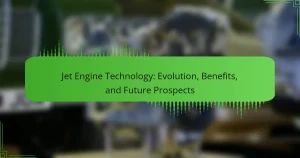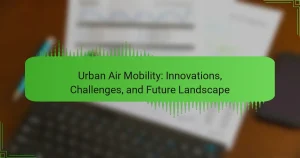The future of transportation is set to revolutionise how we travel, emphasising sustainability and efficiency. Key trends include electrification, automation, and shared mobility. Innovations like electric vehicles and autonomous systems promise to enhance safety and reduce costs. Global policies and regional challenges will shape this transformative landscape, while changing consumer behaviours prioritise eco-friendly options and convenience.

What are the key trends shaping the future of transportation?
Key trends shaping the future of transportation include electrification, automation, and shared mobility. These trends are driven by advancements in technology and a growing emphasis on sustainability.
Electrification involves the widespread adoption of electric vehicles, reducing greenhouse gas emissions and reliance on fossil fuels. Automation focuses on the development of self-driving technology, enhancing safety and efficiency on the roads. Shared mobility promotes the use of ride-sharing and public transportation, decreasing traffic congestion and improving urban planning.
As a result, these trends are transforming global transportation systems, leading to more efficient, environmentally friendly, and accessible travel options for communities worldwide.
How is urbanisation influencing transportation needs?
Urbanisation significantly increases transportation needs by driving demand for efficient, sustainable mobility solutions. As cities grow, congestion and pollution rise, prompting innovations like electric vehicles and public transit enhancements. Urban areas require integrated transport systems to accommodate population density and reduce carbon footprints. The shift towards smart transportation technologies is essential for addressing these evolving challenges.
What role does sustainability play in transportation innovations?
Sustainability is crucial in transportation innovations as it drives the development of eco-friendly technologies. These innovations aim to reduce carbon emissions, enhance energy efficiency, and promote the use of renewable resources. Electric vehicles exemplify this trend, offering significant reductions in greenhouse gas emissions compared to traditional vehicles. Additionally, public transportation systems are evolving to incorporate sustainable practices, such as using alternative fuels and optimising routes for efficiency. As a result, sustainability not only shapes transportation solutions but also aligns with global efforts to combat climate change.
Which technologies are driving the shift towards electric vehicles?
Electric vehicles are driven by advancements in battery technology, charging infrastructure, and software innovations. These technologies enhance efficiency and user experience while reducing emissions.
Battery technology, particularly lithium-ion advancements, has increased energy density and reduced costs, making electric vehicles more affordable. Fast-charging stations are expanding globally, enabling convenient long-distance travel. Additionally, software developments in autonomous driving and vehicle-to-grid technology optimise energy use and improve performance.
As a result, the shift towards electric vehicles is accelerating, supported by government incentives and consumer demand for sustainable transportation solutions.
How are autonomous vehicles changing the landscape of transportation?
Autonomous vehicles are revolutionising transportation by enhancing safety, efficiency, and accessibility. They reduce human error, which accounts for 94% of accidents, leading to fewer collisions. These vehicles optimise traffic flow through real-time data analysis, potentially decreasing congestion by 30%. Moreover, they offer mobility solutions for individuals unable to drive, improving inclusivity. As cities adapt to this technology, infrastructure will evolve, integrating smart traffic systems and charging stations. This shift will significantly impact urban planning and public transportation models, paving the way for sustainable travel solutions.
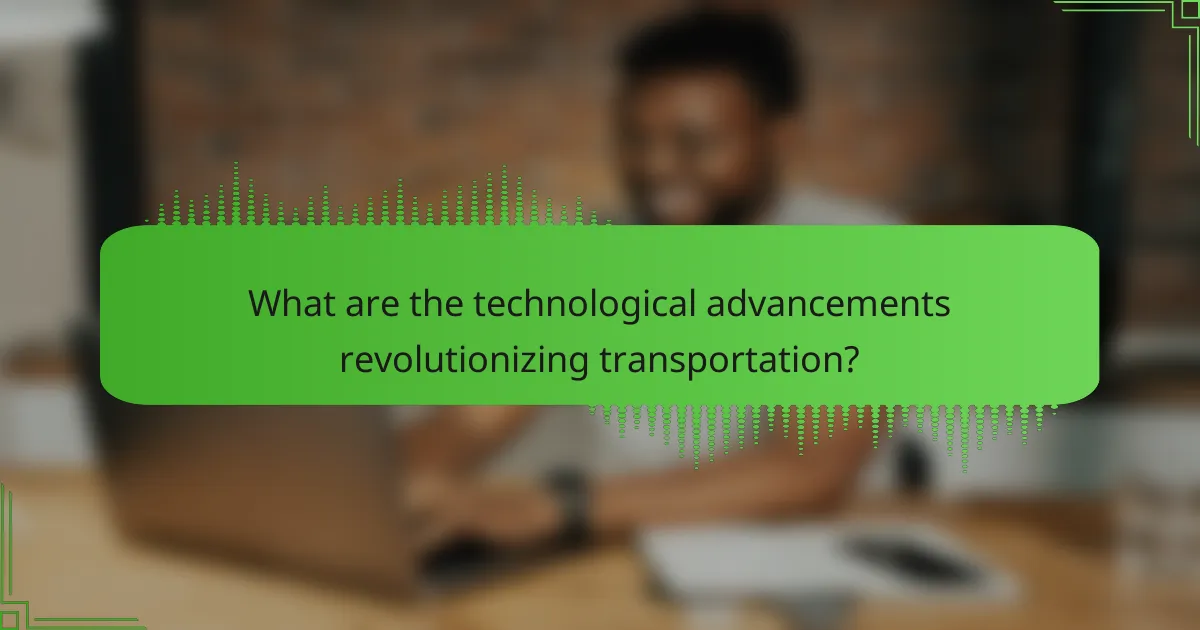
What are the technological advancements revolutionising transportation?
Technological advancements such as electric vehicles, autonomous driving, and hyperloop systems are transforming transportation. Electric vehicles reduce emissions and operating costs, while autonomous driving enhances safety and efficiency. Hyperloop technology promises ultra-fast travel, potentially cutting intercity travel times significantly. These innovations aim to improve sustainability and connectivity globally.
How is artificial intelligence enhancing logistics and supply chain management?
Artificial intelligence significantly enhances logistics and supply chain management by optimising operations and improving decision-making. AI analyses vast data sets to forecast demand, streamline inventory management, and enhance route planning.
AI-powered predictive analytics can reduce delivery times by 20% and decrease operational costs by 15%. Machine learning algorithms identify inefficiencies, enabling companies to adjust strategies in real-time. Furthermore, AI improves customer satisfaction by providing accurate tracking and personalised delivery options.
Robotics and automation, driven by AI, are transforming warehousing and fulfilment processes. Automated systems can handle inventory with precision, reducing human error and increasing efficiency. As a result, businesses can scale operations quickly while maintaining quality and reliability.
The integration of AI in supply chains fosters resilience against disruptions. Companies can adapt to changes in demand or supply quickly, ensuring continuity and competitiveness in a rapidly evolving market.
What impact do smart cities have on transportation infrastructure?
Smart cities significantly enhance transportation infrastructure by integrating advanced technologies. These innovations improve traffic management, reduce congestion, and promote sustainable mobility. For example, smart traffic signals adapt in real-time to traffic flow, optimising vehicle movement. Additionally, data-driven analytics support public transport efficiency, ensuring timely services. The unique attribute of smart cities is their ability to foster connectivity between various transportation modes, making urban mobility seamless. As a result, cities can reduce carbon emissions and improve air quality, contributing to a healthier environment.
Which innovations are emerging in public transportation systems?
Emerging innovations in public transportation systems include electric vehicles, autonomous shuttles, and smart ticketing solutions. These advancements aim to enhance efficiency, reduce emissions, and improve user experience. Electric buses, for example, are being adopted globally, providing a cleaner alternative to traditional diesel models. Autonomous technology is transforming operations, enabling driverless public transport options. Smart ticketing systems streamline fare collection, making travel more convenient for users. Collectively, these innovations shape a sustainable future for urban mobility.
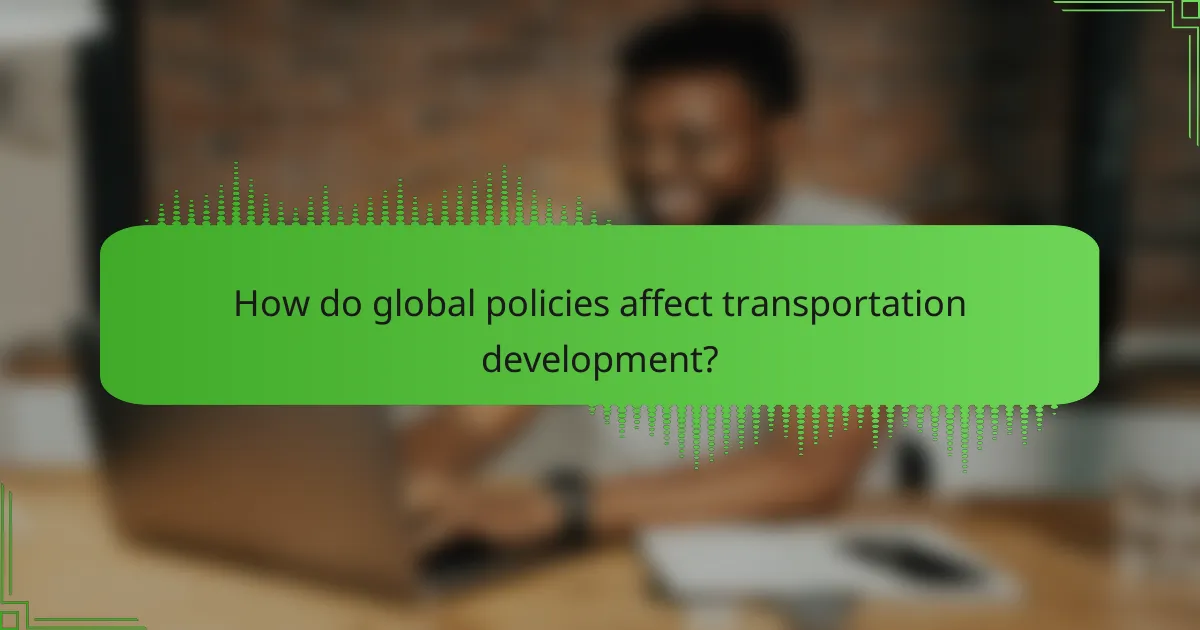
How do global policies affect transportation development?
Global policies significantly shape transportation development by influencing regulations, funding, and technological adoption. Policies aimed at sustainability drive the integration of electric vehicles and public transit systems. For instance, the Paris Agreement promotes investments in low-emission transport solutions. Additionally, trade agreements facilitate infrastructure projects, enhancing connectivity across regions. As a result, global collaboration fosters innovation in transportation technologies, addressing climate change and urbanisation challenges.
What are the implications of international regulations on emissions?
International regulations on emissions significantly impact the future of transportation by enforcing standards that drive innovation and sustainability. These regulations aim to reduce greenhouse gas emissions, encouraging the adoption of cleaner technologies. As a result, manufacturers must invest in electric vehicles and alternative fuels, reshaping market dynamics. Compliance can also lead to increased operational costs, influencing pricing strategies across the industry. Additionally, global cooperation on emissions standards fosters competitive advantages for early adopters of green technologies, driving further advancements in transportation solutions.
How are trade agreements influencing transportation networks?
Trade agreements significantly influence transportation networks by streamlining logistics and reducing tariffs. These agreements foster collaboration among nations, enhancing infrastructure investments and creating efficient trade routes. For example, the North American Free Trade Agreement improved cross-border transport, leading to increased trade volume. As a result, transportation networks adapt to accommodate higher demands, integrating advanced technologies like AI for route optimisation and tracking. The unique attribute of these agreements is their ability to reshape regional supply chains, making them more resilient and responsive to global market changes.
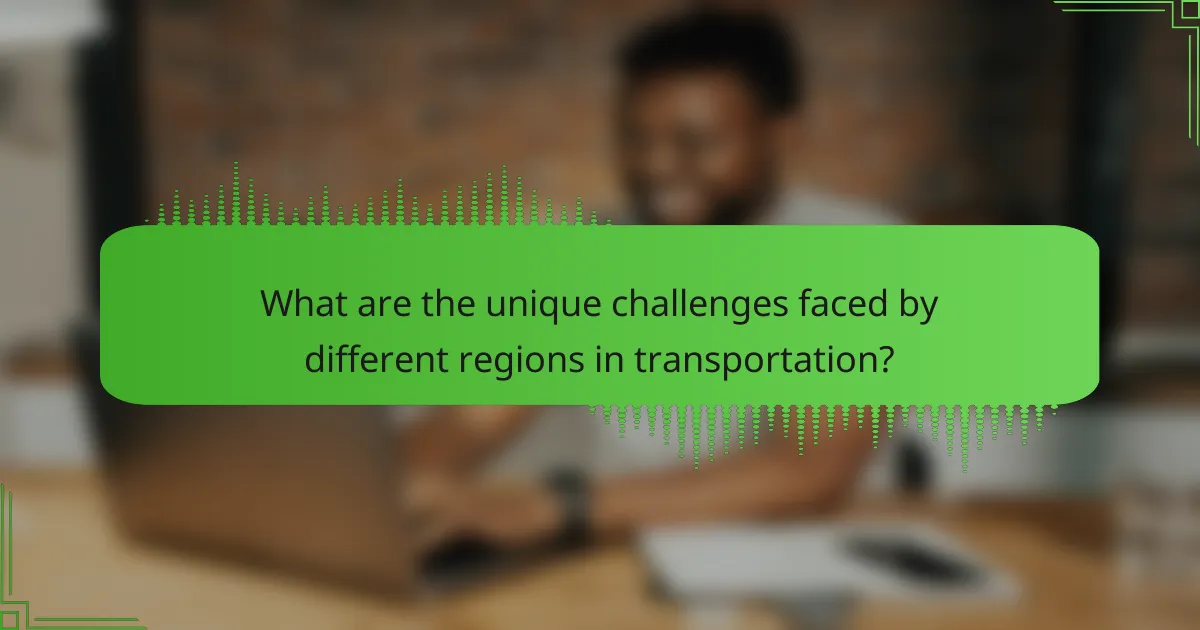
What are the unique challenges faced by different regions in transportation?
Different regions face unique transportation challenges due to geographic, economic, and infrastructural factors. Urban areas struggle with congestion, while rural regions often lack connectivity. Developing countries may experience inadequate infrastructure, hindering efficient transport. Climate change impacts coastal regions, increasing vulnerability to flooding. Additionally, varying regulatory environments can complicate logistics and compliance. Addressing these challenges requires tailored solutions that consider each region’s specific needs and capabilities.
How does geography impact transportation infrastructure in urban areas?
Geography significantly impacts transportation infrastructure in urban areas by shaping the layout and accessibility of transport networks. Urban regions with diverse topographies, such as hills or rivers, require innovative solutions for effective connectivity.
For instance, cities like San Francisco utilise cable cars and steep street designs due to their hilly geography. In contrast, flat cities like Chicago can implement extensive road networks and public transit systems more easily.
Additionally, geographical factors influence the distribution of resources, affecting transportation demand and infrastructure development. Urban areas near coastlines often prioritise ports, while those near mountains may focus on tunnels and bridges.
As urbanisation continues, understanding these geographical influences will be vital for sustainable and efficient transportation planning.
What are the specific transportation needs of developing countries?
Developing countries require affordable, accessible, and sustainable transportation solutions. Key needs include improved infrastructure, reliable public transport systems, and innovative technologies like electric vehicles and shared mobility services.
These regions often face challenges such as limited funding, inadequate road networks, and high vehicle ownership costs. As a result, prioritising investments in mass transit options can enhance mobility and economic growth.
Furthermore, integrating technology can address unique needs, such as mobile apps for ride-sharing or real-time public transport information. These advancements can significantly improve transportation efficiency and accessibility in developing areas.
Addressing these specific needs fosters sustainable development and enhances the quality of life for residents.

How is consumer behaviour evolving in response to transportation changes?
Consumer behaviour is increasingly prioritising sustainability and convenience due to transportation changes. Innovations like electric vehicles and shared mobility services are reshaping preferences. Consumers now seek eco-friendly options, influencing market demand and shaping urban planning. Additionally, advancements in technology, such as autonomous vehicles, are altering perceptions of safety and accessibility, leading to shifts in travel habits. As a result, the future of transportation will likely focus on integrated, user-centred solutions that align with evolving consumer values.
What preferences do consumers have regarding shared mobility services?
Consumers prefer shared mobility services that offer convenience, affordability, and flexibility. Key preferences include real-time tracking, user-friendly apps, and diverse vehicle options. Safety features and environmental sustainability also significantly influence consumer choices. Additionally, loyalty programmes and seamless payment methods enhance user satisfaction.
How does the rise of remote work affect transportation demand?
The rise of remote work decreases transportation demand significantly. As more employees work from home, daily commuting reduces, leading to lower traffic congestion and decreased public transport usage.
This shift impacts various transportation sectors. For instance, the demand for public transit systems has declined by approximately 50% in urban areas during peak remote work periods. Additionally, ride-sharing services experience reduced usage, affecting their operational models.
Long-term implications suggest a potential restructuring of urban planning and infrastructure investments as cities adapt to changing transportation needs. This transition may lead to increased investments in cycling and pedestrian-friendly initiatives, promoting sustainable transportation options.
In summary, remote work reshapes transportation demand, fostering a shift towards more sustainable and less congested urban environments.
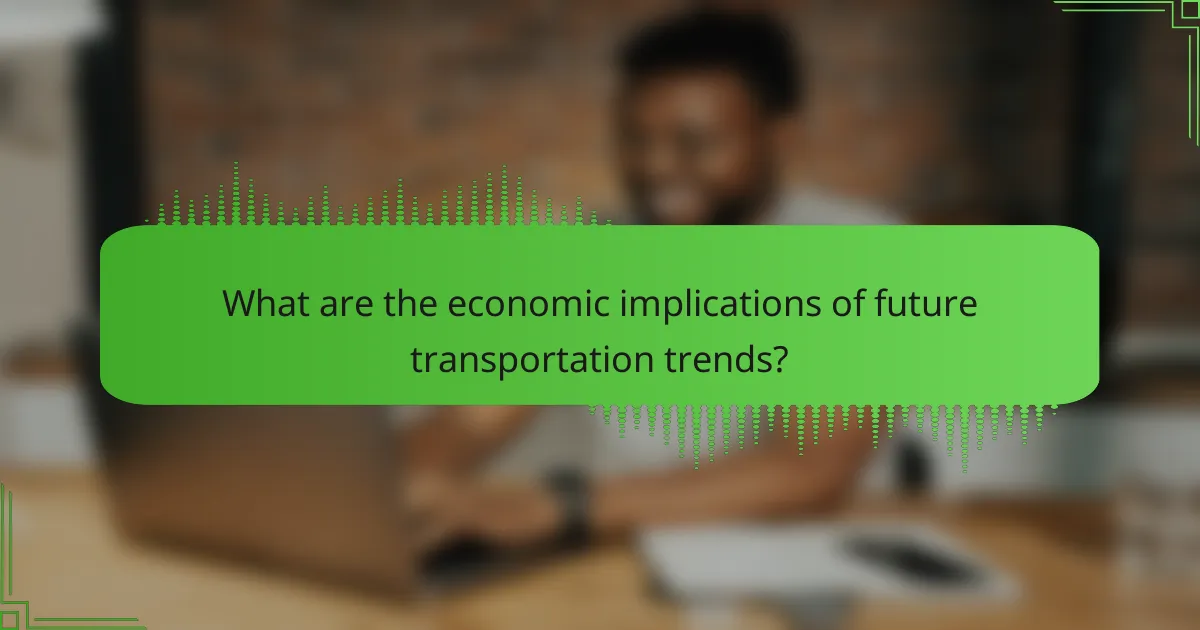
What are the economic implications of future transportation trends?
Future transportation trends will significantly impact global economies by enhancing efficiency and reducing costs. Innovations like electric vehicles and autonomous transport will reshape industries and job markets.
For example, electric vehicle adoption can decrease fuel dependency, leading to lower transportation costs. Autonomous systems may streamline logistics, increasing supply chain efficiency and reducing delivery times.
Additionally, investments in infrastructure for sustainable transport can stimulate economic growth, creating jobs in construction and technology sectors. As a result, cities may experience improved air quality and reduced congestion, contributing to overall economic health.
In summary, the economic implications of future transportation trends will be profound, influencing costs, job markets, and urban development.
How do transportation advancements influence job markets?
Transportation advancements significantly reshape job markets by creating new opportunities and altering existing roles. Innovations like autonomous vehicles and electric mobility enhance efficiency, leading to demand for skilled workers in tech and engineering sectors. As companies adopt these technologies, they require training programmes to equip employees with necessary skills, influencing workforce development. Additionally, shifts in logistics and supply chain management due to improved transportation methods can lead to job growth in related fields. Overall, the evolution of transportation directly correlates with job creation and transformation across various industries.
What is the potential impact on local economies from new transportation technologies?
New transportation technologies can significantly boost local economies by enhancing connectivity, reducing travel time, and creating jobs. Improved public transit systems and electric vehicle infrastructure attract businesses and increase property values. For instance, cities adopting autonomous vehicle technology may see reduced congestion and increased safety, leading to economic growth. Additionally, innovations like hyperloop systems can open new markets, enabling easier access to resources and services. Overall, the integration of these technologies fosters sustainable development and revitalises urban areas.

What are the safety considerations in future transportation systems?
Safety considerations in future transportation systems focus on minimising risks and enhancing security. Key aspects include vehicle automation, cybersecurity, and infrastructure resilience.
1. Vehicle automation: Autonomous vehicles must ensure safety through advanced sensors and algorithms to prevent accidents.
2. Cybersecurity: Protecting transportation systems from cyber threats is crucial as increased connectivity exposes vulnerabilities.
3. Infrastructure resilience: Future systems require robust infrastructure that can withstand environmental changes and disasters.
4. Regulatory frameworks: Comprehensive regulations are needed to govern new technologies and ensure public safety.
5. Public acceptance: Gaining public trust is essential for the widespread adoption of innovative transportation solutions.
How is data privacy being addressed in autonomous vehicle technology?
Data privacy in autonomous vehicle technology is being addressed through robust data encryption, user consent protocols, and anonymisation techniques. These measures ensure that personal information is protected while still allowing for data analysis needed for safety and efficiency.
Manufacturers are implementing advanced cybersecurity frameworks to safeguard against breaches. For instance, real-time monitoring systems detect and respond to potential threats. Additionally, regulatory compliance is becoming a priority, with companies adhering to standards such as GDPR.
Public awareness and education about data privacy rights are also crucial. As consumers become more informed, they demand transparency regarding data usage. This shift influences how manufacturers design their privacy policies and technology.
The future of transportation will likely see continuous evolution in data privacy measures, keeping pace with technological advancements and regulatory changes. This proactive approach aims to build consumer trust and ensure the safe integration of autonomous vehicles into society.
What measures are being implemented to enhance cybersecurity in transportation?
Measures to enhance cybersecurity in transportation include adopting advanced encryption, implementing real-time monitoring systems, and conducting regular security assessments. These strategies protect critical infrastructure from cyber threats. For example, the use of artificial intelligence helps identify vulnerabilities proactively. Additionally, collaboration between public and private sectors strengthens defenses against potential attacks.
What are the common mistakes to avoid when adopting new transportation technologies?
Common mistakes when adopting new transportation technologies include inadequate research, overlooking user needs, underestimating costs, and failing to ensure interoperability. These errors can hinder successful implementation and limit the potential benefits of innovative solutions. Addressing these issues early on enhances the effectiveness and acceptance of new technologies in the transportation sector.

